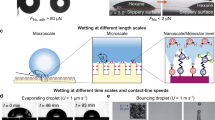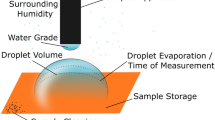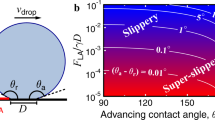Abstract
Wetting, the process of water interacting with a surface, is critical in our everyday lives and in many biological and technological systems. The contact angle is the angle at the interface where water, air and solid meet, and its value is a measure of how likely the surface is to be wetted by the water. Low contact-angle values demonstrate a tendency of the water to spread and adhere to the surface, whereas high contact-angle values show the surface’s tendency to repel water. The most common method for surface-wetting characterization is sessile-drop goniometry, due to its simplicity. The method determines the contact angle from the shape of the droplet and can be applied to a wide variety of materials, from biological surfaces to polymers, metals, ceramics, minerals and so on. The apparent simplicity of the method is misleading, however, and obtaining meaningful results requires minimization of random and systematic errors. This article provides a protocol for performing reliable and reproducible measurements of the advancing contact angle (ACA) and the receding contact angle (RCA) by slowly increasing and reducing the volume of a probe drop, respectively. One pair of ACA and RCA measurements takes ~15–20 min to complete, whereas the whole protocol with repeat measurements may take ~1–2 h. This protocol focuses on using water as a probe liquid, and advice is given on how it can be modified for the use of other probe liquids.
This is a preview of subscription content, access via your institution
Access options
Access Nature and 54 other Nature Portfolio journals
Get Nature+, our best-value online-access subscription
$29.99 / 30 days
cancel any time
Subscribe to this journal
Receive 12 print issues and online access
$259.00 per year
only $21.58 per issue
Buy this article
- Purchase on Springer Link
- Instant access to full article PDF
Prices may be subject to local taxes which are calculated during checkout










Similar content being viewed by others
Change history
07 August 2018
The version of this Protocol originally published contained typographical errors that affected the accuracy/readability of the text. In Fig. 4e, the line “Contact angle remainsstable” should have read “Contact angle remains stable.” In Table 1, in the “Advantages” column, the second instance of “Simple” was incorrectly associated with the “Sessile-drop goniometry” method; it should have corresponded to the “Tilting plate” method. In Table 2, in the “Issues” column, the entry “Difficult to place baseline when the RCA is ~90°” was broken incorrectly in a way that might have suggested that “the RCA is ~90°” was a separate issue. These errors have been corrected in the HTML and PDF versions of the paper.
References
Riederer, M. & Schreiber, L. Protecting against water loss: analysis of the barrier properties of plant cuticles. J. Exp. Bot. 52, 2023–2032 (2001).
Gao, X. & Jiang, L. Water-repellent legs of water striders. Nature 432, 36 (2004).
Barthlott, W. & Neinhuis, C. Purity of the sacred lotus, or escape from contamination in biological surfaces. Planta 202, 1–8 (1997).
Parker, A. R. & Lawrence, C. R. Water capture by a desert beetle. Nature 414, 33–34 (2001).
Zhao, G. et al. High surface energy enhances cell response to titanium substrate microstructure. J. Biomed. Mater. Res. Part A 74, 49–58 (2005).
Pankaj, S. K. et al. Applications of cold plasma technology in food packaging. Trends Food Sci. Technol. 35, 5–17 (2014).
Tian, D., Song, Y. & Jiang, L. Patterning of controllable surface wettability for printing techniques. Chem. Soc. Rev. 42, 5184–5209 (2013).
Korhonen, J. T., Kettunen, M., Ras, R. H. A. & Ikkala, O. Hydrophobic nanocellulose aerogels as floating, sustainable, reusable, and recyclable oil absorbents. ACS Appl. Mater. Interfaces 3, 1813–1816 (2011).
Young, T. An essay on the cohesion of fluids. Philos. Trans. R. Soc. Lond. 95, 65–87 (1805).
Extrand, C. W. & Kumagai, Y. An experimental study of contact angle hysteresis. J. Colloid Interface Sci. 191, 378–383 (1997).
Marmur, A. Solid surface characterization by wetting. Annu. Rev. Mater. Res. 39, 473–489 (2009).
Marmur, A. A guide to the equilibrium contact angles maze in Contact Angle, Wettability and Adhesion Vol. 6 3–18 (ed. Mittal K. L.) (CRC Press, 2009).
Quéré, D. Wetting and roughness. Annu. Rev. Mater. Res. 38, 71–99 (2008).
Andrieu, C., Sykes, C. & Brochard, F. Average spreading parameter on heterogeneous surfaces. Langmuir 104, 2077–2080 (1994).
de Gennes, P. G. Wetting: statics and dynamics. Rev. Mod. Phys. 57, 827–863 (1985).
Blake, T. D. The physics of moving wetting lines. J. Colloid Interface Sci. 299, 1–13 (2006).
Drelich, J. Guidelines to measurements of reproducible contact angles using a sessile-drop technique. Surf. Innov. 1, 248–254 (2013).
Good, R. J. Contact angle, wetting, and adhesion: a critical review. J. Adhes. Sci. Technol. 6, 1269–1302 (1992).
Kwok, D. Y. & Neumann, A. W. Contact angle measurement and contact angle interpretation. Adv. Colloid Interface Sci. 81, 167–249 (1999).
Lam, C. N. C., Lu, J. J. & Neumann, A. W. Measuring contact angle. in Handbook of Applied Surface and Colloid Chemistry (ed. K. Holmberg) Vol. 2 251–277 (2002).
Della Volpe, C. & Siboni, S. The Wilhelmy method : a critical and practical review. Surf. Innov. 6, 120–132 (2018).
Liimatainen, V. et al. Mapping microscale wetting variations on biological and synthetic water-repellent surfaces. Nat. Commun. 8, 1798 (2017).
Pierce, E., Carmona, F. J. & Amirfazli, A. Understanding of sliding and contact angle results in tilted plate experiments. Colloids Surf. A Physicochem. Eng. Asp. 323, 73–82 (2008).
Krasovitski, B. & Marmur, A. Drops down the hill: theoretical study of limiting contact angles and the hysteresis range on a tilted plate. Langmuir 21, 3881–3885 (2005).
Rudawska, A. & Jacniacka, E. Analysis for determining surface free energy uncertainty by the Owen-Wendt method. Int. J. Adhes. Adhes. 24, 451–457 (2009).
Zhao, Q., Liu, Y. & Abel, E. W. Effect of temperature on the surface free energy of amorphous carbon films. J. Colloid Interface Sci. 280, 174–183 (2004).
Hoorfar, M. & Neumann, A. W. Recent progress in axisymmetric drop shape analysis (ADSA). Adv. Colloid Interface Sci. 121, 25–49 (2006).
Tavana, H. & Neumann, A. W. On the question of rate-dependence of contact angles. Colloids Surf. A Physicochem. Eng. Asp. 282–283, 256–262 (2006).
Korhonen, J. T., Huhtamäki, T., Ikkala, O. & Ras, R. H. A. Reliable measurement of the receding contact angle. Langmuir 29, 3858–3863 (2013).
Grundke, K. et al. Experimental studies of contact angle hysteresis phenomena on polymer surfaces - toward the understanding and control of wettability for different applications. Adv. Colloid Interface Sci. 222, 350–376 (2015).
Acknowledgements
The protocol is the result of a procedure gradually developed since wetting research was begun in the R.H.A.R. group, and we acknowledge the contributions of H. Mertaniemi, T. Verho and M. Latikka. This work was supported by the European Research Council ERC-2016-CoG (725513-SuperRepel) and the Academy of Finland (Centres of Excellence Programme 2014–2019). X.T. is grateful for the support of the One Hundred Talents Program of SYSU and the One Thousand Youth Talents Program of China.
Author information
Authors and Affiliations
Contributions
R.H.A.R. coordinated the project. T.H., X.T. and J.T.K. performed the experiments. All authors participated in designing the protocol. T.H. and R.H.A.R. wrote the manuscript with contributions from all authors. J.T.K. wrote the Python code.
Corresponding author
Ethics declarations
Competing interests
The authors declare no competing interests.
Additional information
Publisher’s note: Springer Nature remains neutral with regard to jurisdictional claims in published maps and institutional affiliations.
Related links
Reliable measurement of the receding contact angle: https://doi.org/10.1021/la400009m
Guidelines to measurements of reproducible contact angles using a sessile-drop technique: https://doi.org/10.1680/si.13.00010
Characterization of super liquid-repellent surfaces: https://doi.org/10.1016/j.cocis.2014.04.009
Supplementary information
Supplementary Methods: Python code for solving the Young–Laplace equation.
The minimum advancing drop volumes (= the recommended starting volume for the receding contact-angle measurement) needed to reach RCA at 10 µL (Fig. 6), were obtained by solving the Young–Laplace equation by numerical integration, using Python programming language with Scipy library. The shape and size of the drop for different pairs of contact angle and drop volume were solved using a code that is provided in this supplementary file
Rights and permissions
About this article
Cite this article
Huhtamäki, T., Tian, X., Korhonen, J.T. et al. Surface-wetting characterization using contact-angle measurements. Nat Protoc 13, 1521–1538 (2018). https://doi.org/10.1038/s41596-018-0003-z
Published:
Issue Date:
DOI: https://doi.org/10.1038/s41596-018-0003-z
This article is cited by
-
Wetting and evaporation behavior of dilute sodium dodecyl sulfate droplets on soft substrates under a direct current electric field
Scientific Reports (2024)
-
Chemical and structural heterogeneity of olive leaves and their trichomes
Communications Biology (2024)
-
Droplet slipperiness despite surface heterogeneity at molecular scale
Nature Chemistry (2024)
-
Understanding the light induced hydrophilicity of metal-oxide thin films
Nature Communications (2024)
-
Effect of equilibrium contact angle on water equilibrium film thickness for the carbon dioxide–brine–mineral system based on surface force theory
Journal of Petroleum Exploration and Production Technology (2024)
Comments
By submitting a comment you agree to abide by our Terms and Community Guidelines. If you find something abusive or that does not comply with our terms or guidelines please flag it as inappropriate.



